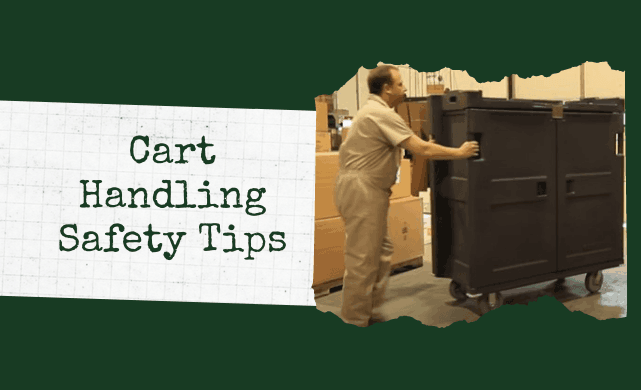Have you ever been to a factory and watched veteran staff effortlessly maneuver a utility cart from row to row, making quick turns with heavy loads? Now think about the last time you were at a big box building supply store and you or someone you watched never seemed to get the cart to go easily go in the intended direction. Knowing how to push and pull a cart safely is paramount to easily the transport of items with any type of cart including laundry carts, meal delivery carts and utility carts.
Transporting heavy loads on a cart, particularly in tight spaces or around a variety of obstacles, can be hard on your body. Pushing, pulling or turning the cart to maneuver it to the final destination subjects your body to a variety of stressors; including joint compression, torque and shearing forces. For individuals that do this regularly, over time they may experience pain in their lower back, knee strain and other musculoskeletal disorders (MDSs). Having a cart with an ergonomic design can alleviate some of the strain, as can good ergonomic practices on the part of the individual who pushes the cart.
Here are four easy-to-implement ergonomic practices that every worker who pushes any type of cart should implement to prevent injuries and back pain from cart handling:
1. Reduce the Weight
The single most important factor(1) to the amount of physical stress placed on a person pushing a cart is the total weight of the cart being handled. This includes the weight of the load and the cart. Any reduction to the maximum weight loads that are routinely handled is likely to lower MSDs. In those instances where it isn’t feasible to lower total cart weight, the use of power equipment like a tugger can assist. At Cook’s, we have customized some of our meal delivery carts with a tow hitch to allow customers to move carts by attaching them to vehicles that move throughout the larger facilities.
2. Keep Moving
A cart that rolls easily is much easier to move and causes less strain on the muscles and joints of the individual that is pushing that cart. One of the biggest factor in the ease of moving a cart is the type of caster and the condition of the casters. The size and material of the caster influences how easily they function. Larger wheels have less resistance when being pushed as do harder materials, but they need to be appropriate to the floor type. To learn more about casters, refer to our blog post Why is the right caster so important?
Check to be sure that wheels are rolling freely and not bound up in any way or that pneumatic tires are fully inflated. Anything to impair the functionality of a caster will create undue stress on the body as the cart is being pushed.
3. Hold On Right
The design and position of the handle will influence the ease of moving a cart. The challenge here is that bodies aren’t consistent so the positioning of a handle may not accommodate everyone. Consider the difference in handle height needed for someone that is 6’ vs a person who is 5’ 6”. Not only is their height different but, most likely, so is the length of their arms. But it’s not event hat different individuals have different optimal grip heights, even the same person will have a different optimal grip height depending on the action they are performing. Pushing, pulling and turning the cart left or right, may all involve a different grip, additionally, the weight of the cart will influence the grip position.
Carts that have a handle or handles which offer a range of grip positions and heights provide the greatest opportunity for users to change position according to the individuals height and body type as well as the task being performed. Handles that are raised or have angled portions can also allow for a variety of grips.
4. Shorten the Distance
Whenever possible, limit the distance that a heavy load is pushed or pulled. According to an article in EHS Today, the maximum distance that a heavily loaded cart should be moved is 200 feet. For longer distances, powered trucks or the use of a tugger, is recommended.(2)
All of these practices should be implemented into any work that involves pulling or pushing of carts, but don’t forget that experience will also improve a workers ability to facilitate safe cart handling. Remember the veteran material handlers vs shoppers at the building supply store trying to push awkward, heavy loads with difficulty? Research has shown that individuals who are experienced in material handling, particularly with cart transport, have better technique when using carts that reduces the strain on their bodies and the risk of injury. Experienced material handlers innately use their body as a lever and create a hinge movement allowing them to lean in against the weight when pushing and lean back against the weight when pulling. The same research was not able to determine if this good technique could be taught to new workers or if it was something learned only through hands on experience, so starting new employees with these safety practices will reduce the risk of injury in your workplace.
(1) Reference sited from Human Body Mechanics of Pushing and Pulling: Analyzing the Factors of Task-related Strain on the Musculoskeletal System (nih.gov)
(2) Reference sited from Applying Manual Material-Handling Guidelines to Job Tasks | EHS Today
